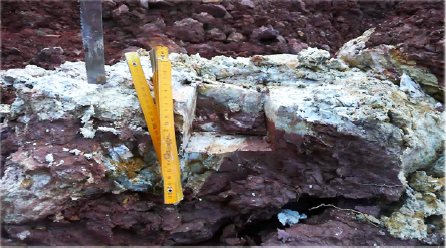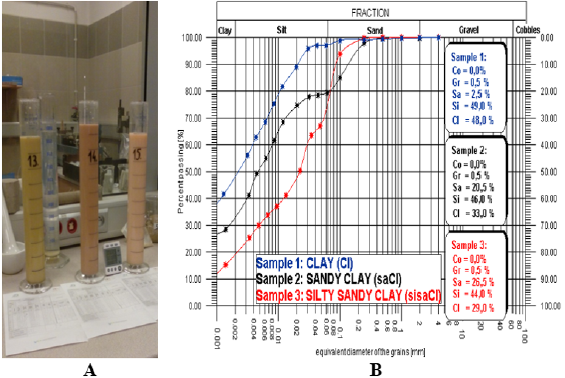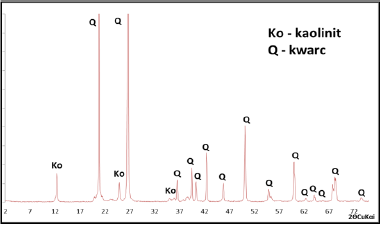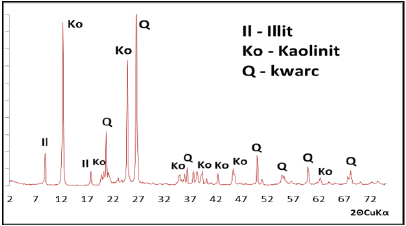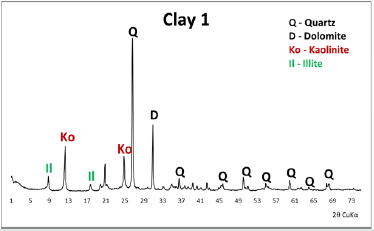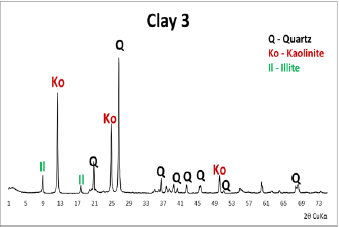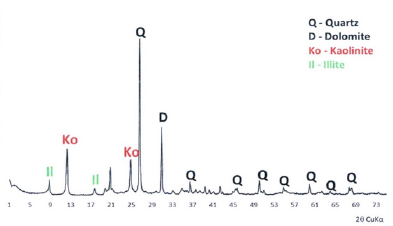
Lupine Publishers Group
Lupine Publishers
Menu
ISSN: 2641-6794
Research Article(ISSN: 2641-6794) 
Mineral Supplements of Soils Volume 2 - Issue 4
Maciej Pawlikowski1* and David Kozień2
- 1AGH-University of Science and Technology, Cath. Mineralogy, Petrography and Geochemistry, Cracow, Poland
- 2Student’s Geological Association, AGH–University of Science and Technology, Cracow, Poland
Received: April 23, 2019; Published: May 06, 2019
Corresponding author: Maciej Pawlikowski, AGH-University of Science and Technology, Cath. Mineralogy, Petrography and Geochemistry, Cracow, Poland
DOI: 10.32474/OAJESS.2019.02.000145
Abstract
- Abstract
- Introduction
- Material and Methods of Research
- Microscopic Tests in Polarized Saint Lighting
- Analysis of the External Matrix of Natural Tests Used by the XRD Method
- Results Designated by Content of The Content of the Cross-Fraction on a Standing Water Post
- Results of the Analysis of the Quarter of Quartz Grassing and Distribution of Minerals of Chlorine Minerals in Granulates SEM
- Summary
- References
Improving soil quality results in increased yields and benefits for farmers. Research has been carried out on the use of selected mineral waste collected in heaps to improve the quality of poor soils. The natural soil supplements obtained in this way will not only improve their quality and increase polonies but will also allow the liquidation of some of the heaps. This will contribute to the reclamation of the landscape and the environment.
Introduction
- Abstract
- Introduction
- Material and Methods of Research
- Microscopic Tests in Polarized Saint Lighting
- Analysis of the External Matrix of Natural Tests Used by the XRD Method
- Results Designated by Content of The Content of the Cross-Fraction on a Standing Water Post
- Results of the Analysis of the Quarter of Quartz Grassing and Distribution of Minerals of Chlorine Minerals in Granulates SEM
- Summary
- References
Soil and agricultural crops have been the object of multidirectional interests since ancient times. This is documented in scientific literature. Among other publications, a large part deals with those that concern soil as a source of nutrients for plants [1-5]. Another important field of research is publications on the role of soil fauna in improving soil quality [6-18]. Another research complex is geochemical research on the relationship of chemical fertilizers - improving the performance of soil with particular regard to the toxicity of additives, in particular those containing radioactive elements [19-24]. A lot of publications address the problem of the relation of fauna, and soil flora and its mineral composition [25-28] as well as the influence of mineral factors on the development of individual plant elements [4,5,29]. There are also publications on the use of organic waste for fertilization glkeb [30-33], the role of soil sun exposure in stabilizing its beneficial properties [34,35] and the use of the so-called. antagonistic plants [36,37].
A separate section is soil relations - geology [30,38-40], mineralogy - regulation of physical soil parameters including its water retention capacity [41]. Quite extensive literature concerns the use of natural minerals and rocks to improve the quality of soil and increase the size of crops from it [18,38-50]. It is in this trend that the presented publication is included, bearing in mind the impact of the proposed proceedings on possible environmental modifications [41,51-54].
Material and Methods of Research
- Abstract
- Introduction
- Material and Methods of Research
- Microscopic Tests in Polarized Saint Lighting
- Analysis of the External Matrix of Natural Tests Used by the XRD Method
- Results Designated by Content of The Content of the Cross-Fraction on a Standing Water Post
- Results of the Analysis of the Quarter of Quartz Grassing and Distribution of Minerals of Chlorine Minerals in Granulates SEM
- Summary
- References
The material for the research was taken from the profile of sediments found in the Devonian dolomite deposit exploited in the “Józefka” mine near Kielce (Figure 1). In addition, material from local heaps and granulates made from materials stored in heaps were collected for testing. In order to determine the mineralogical and petrographic characteristics of the obtained rocks, the following tests were carried out:
Figure 1: Wall of the excavation No. 2 of Józefek dolomite quarry. There are described rocks in the overburden.
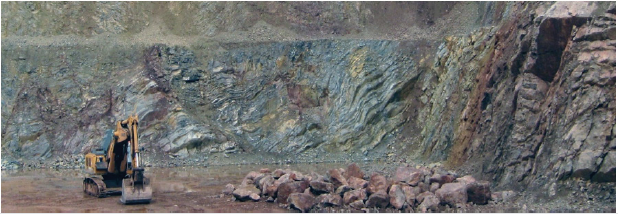
A. Microscopic examination in transmitted and reflected light. The Chinese production of Menij was used. The observed phenomena were documented with micrographs.
B. The analysis of the mineral composition of natural samples was made using the XRD method
C. In order to recognize the content of silty fractions and the clay minerals present in it, samples were sludged.
D. The analysis of the chemical composition of the obtained clay fraction was made using the XRD method
E. Analysis of the degree of quartz grain overlaying and SEM morphology of siliceous minerals as well as the non-standard qualitative analysis of the EDS spectrum (Figure 2.a & 2.b).
Figure 2a: The general appearance of sediments in the dolomite deposition. Silts and clays stained with iron and manganese oxides.
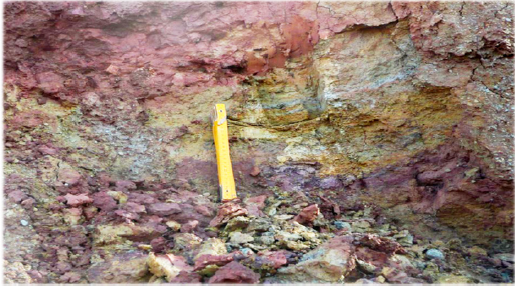
Microscopic Tests in Polarized Saint Lighting
- Abstract
- Introduction
- Material and Methods of Research
- Microscopic Tests in Polarized Saint Lighting
- Analysis of the External Matrix of Natural Tests Used by the XRD Method
- Results Designated by Content of The Content of the Cross-Fraction on a Standing Water Post
- Results of the Analysis of the Quarter of Quartz Grassing and Distribution of Minerals of Chlorine Minerals in Granulates SEM
- Summary
- References
Sand Muck
Structure: aurytowo-psamitowa, texture: compact, random Composition: quartz, min. clay, min. heavy, among which tourmaline was recognized (Figure 3). Degree of sorting of quartz grain on average sorted.
Figure 3: Microscopic photos of sandy silt. A: picture of rock at 1 polaroid, B: picture of rocks in polarized light. Visible quartz grains and brown tourmaline grain. Minerals are located in intergranular spaces.
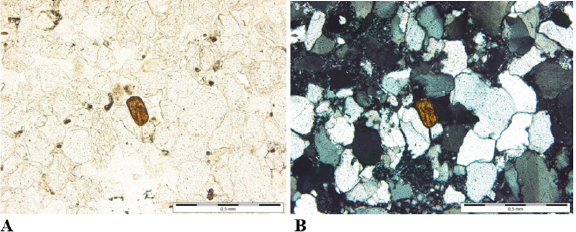
Kaolinite Heel
Structure of silty claystone, texture, texture in places parallel, disturbed. The rock background is a very low birefringent kaolinite mass (Figure 4). In the background of the rocks there are almost exclusively clay minerals, accompanied by single quartz grains with a size of up to 20μm of quartz grain, columnar aggregates of kaolinite in places with a wormlike habit.
Figure 4: Photographs of microscopic kaolinite claystone. A: picture of the rock at 1 polaroid, B: picture of the rock in polarized light. Visible different orientation of kaolinite microaggregates manifested in the variable polarization blanking mode.
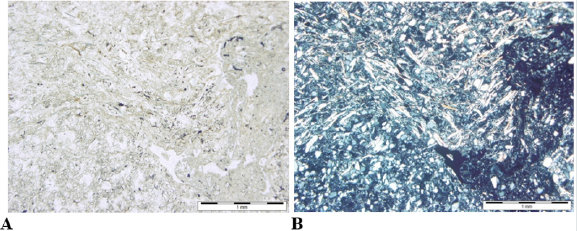
Molecular Muscovite Heel
The clay is a parallel texture made of kaolinite, smectite and muscovite (Figure 5). They are accompanied by single quartz grains.
Figure 5: Microscopic photos for kaolinite-muscovite claystone. A: picture in a non-polarized light, B: A photo in polarized light.
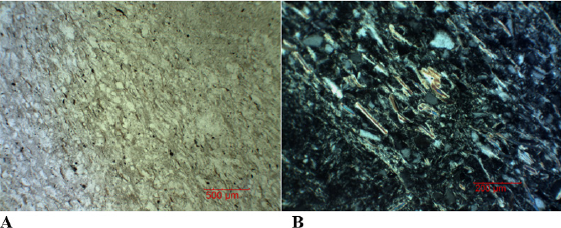
Kaolinite-Illitic Heel
Pellet structure, random texture, disturbed (flow processes) Mineral composition is a mixture of smectite and kaolinite (Figure 6). The microscopic examination shows that the overburden mainly consists of siltstones, sandy mudstones and claystone’s. The sediments are present next to quartz and clay minerals such as kaolinite and smectite also mica. Thanks to microscopic observations, several generations of quartz can be distinguished, as well as iron oxides and hydroxides responsible for the red color of the sediments.
Figure 6: Microscopic images of kaolinite-illite claystone. A: Image in natural light, B: Image in polarized light. in which the granulometric composition was determined. B: granulometric curve of the tested samples.
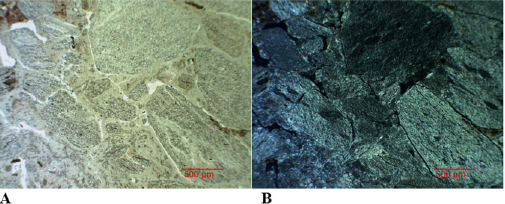
Analysis of the External Matrix of Natural Tests Used by the XRD Method
- Abstract
- Introduction
- Material and Methods of Research
- Microscopic Tests in Polarized Saint Lighting
- Analysis of the External Matrix of Natural Tests Used by the XRD Method
- Results Designated by Content of The Content of the Cross-Fraction on a Standing Water Post
- Results of the Analysis of the Quarter of Quartz Grassing and Distribution of Minerals of Chlorine Minerals in Granulates SEM
- Summary
- References
Due to the uncertainty of the clay components, the polarizing microscopy method was used to test the X-ray diffraction method. Analyzes of natural samples, clayey, prażed and glycolated fractions were performed (Graphs 1,1a,2, 2a,3, 3a,4,4a,5). They allowed to state that beside the detritus components in the overburden samples and heaps there are clay minerals represented by kaolinite and illite. X-ray examinations indicate that all overburden sediments and heaps occurring in the heap contain minerals beneficial for agriculture. They do not contain toxic minerals (Figure 5.a).
Graph 1a: X-ray diffraction pattern for silt sand grain fractions. From the top: raw, roasted and glycolated preparation.
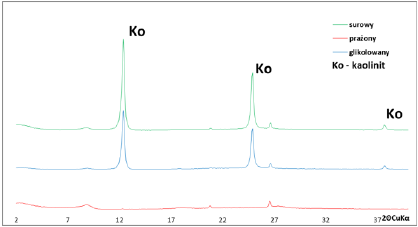
Graph 2.a: X-ray diffractogram of clay fraction of kaolinite claystone. From the top: raw, roasted and glycolated preparation.
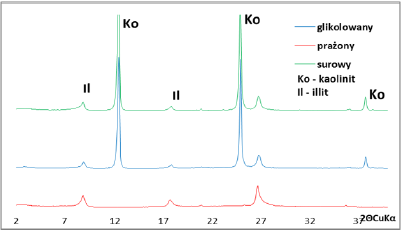
Graph 3.a: X-ray diffractogram for clay fraction of clay-muscovite clay. From the top: raw, roasted and glycolated preparation.
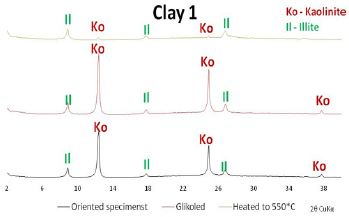
Graph 4.a: X-ray diffractogram for clay fraction of clay-illite clay. From the top: raw, glycolated and roasted preparation.

Results Designated by Content of The Content of the Cross-Fraction on a Standing Water Post
- Abstract
- Introduction
- Material and Methods of Research
- Microscopic Tests in Polarized Saint Lighting
- Analysis of the External Matrix of Natural Tests Used by the XRD Method
- Results Designated by Content of The Content of the Cross-Fraction on a Standing Water Post
- Results of the Analysis of the Quarter of Quartz Grassing and Distribution of Minerals of Chlorine Minerals in Granulates SEM
- Summary
- References
In the case of two samples, the content of clay minerals (fraction <2 μm) in selected samples with extremely small and extremely high clay minerals were tested. They showed that the amount varies both in the overburden material and material from the heap from 3 to 64% by weight (Table 1).
Results of the Analysis of the Quarter of Quartz Grassing and Distribution of Minerals of Chlorine Minerals in Granulates SEM
- Abstract
- Introduction
- Material and Methods of Research
- Microscopic Tests in Polarized Saint Lighting
- Analysis of the External Matrix of Natural Tests Used by the XRD Method
- Results Designated by Content of The Content of the Cross-Fraction on a Standing Water Post
- Results of the Analysis of the Quarter of Quartz Grassing and Distribution of Minerals of Chlorine Minerals in Granulates SEM
- Summary
- References
SEM observations were made for both overburden and granulate deposits. Their distribution in pellets is of great importance as they favor the disintegration of granules and thus the dispersion of granulated material in the enriched soil. Clay minerals in overburden scales are present as aggregates of kaolinite or illite microcells (Figure 7). On the other hand, both on the heap and in the granulate, clay aggregates are degraded by micrometry (Figure 8), which means that in the process of stripping off, staying on heaps and in the granulation process, the clay aggregates disintegrate. This is a favorable phenomenon conducive to material granulation. After pouring on granules, thanks to such a construction, they undergo a faster process of foresting. thanks to which the ingredients of the granules combine with the glaze more quickly.
Figure 7: Kaolinite doline from the dolomite overburden. A: characteristic aggregates made of kaolinite tiles. B: one of the aggregates under magnification.
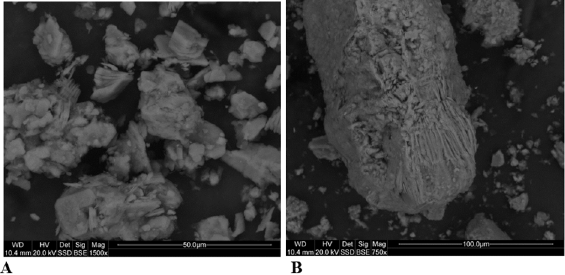
Figure 8: Granules, visible quartz grains (blue arrows) and dolomite (orange arrow) stuck together with clay minerals. SEM image.
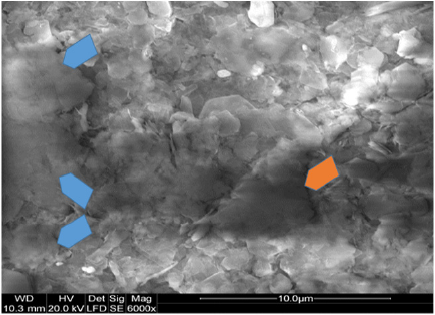
SEM Images (Figures 9-11)
Figure 9: The heap of Józefek quarry. containing overburden rocks collected from the Devonian dolomites.
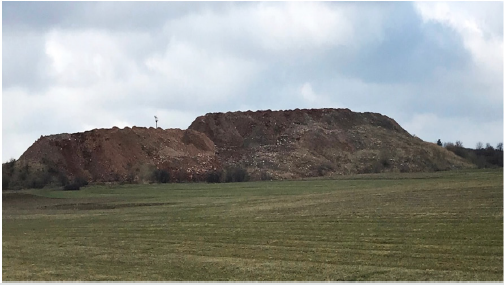
Figure 10: Granules with different granulation of soil supplements with different grain size, which were made from sediments accumulated in heaps.
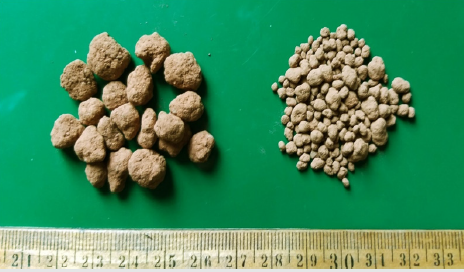
Figure 11: Granular structure observed in the cross-section of granules. Visible dolomite grains in the clay anchor. A: magnification 10 x, B: magnification 20 x.
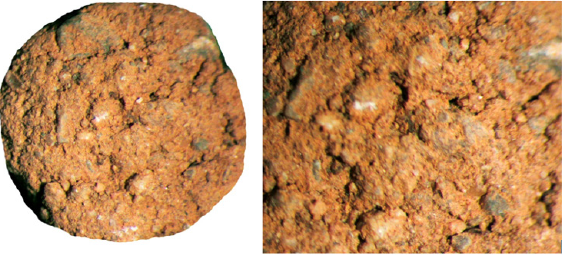
Summary
- Abstract
- Introduction
- Material and Methods of Research
- Microscopic Tests in Polarized Saint Lighting
- Analysis of the External Matrix of Natural Tests Used by the XRD Method
- Results Designated by Content of The Content of the Cross-Fraction on a Standing Water Post
- Results of the Analysis of the Quarter of Quartz Grassing and Distribution of Minerals of Chlorine Minerals in Granulates SEM
- Summary
- References
The performed research indicates that in the dolomite deposit of the Józefka deposit, rocks containing clay minerals from the kaolinite and illite groups as well as quartz, dolomite and calcite are present. The origin of these rocks is not fixed, but for raw material reasons, these rocks are suitable for enriching class IV-VI soils with clay minerals that can provide many ions and promote water retention in soil. Natural granules made from overburden rocks deposited on heaps and small dolomite fractions (waste) can be used as soil supplements enriching it with many elements, including magnesium. It is a beneficial stimulator of biological processes in plants. The use of the described granulates as soil supplements will increase yields, biologically strengthen growing plants and contribute to increasing harvests, and thus will increase the profits of agricultural producers. Both magnesium and other elements that will be delivered to the soil with granules will naturally become the building blocks of plant tissues. In the production and processing cycle, they will then be transferred to organisms using the bred plants. These soil supplements are completely natural and do not contain synthetic toxic substances. They are therefore environmentally friendly and human. The use of granules in the described form will not only strengthen the soil, but will also help to eliminate mineral heaps, favoring the reclamation of mining areas and restoring them to natural conditions.
References
- Abstract
- Introduction
- Material and Methods of Research
- Microscopic Tests in Polarized Saint Lighting
- Analysis of the External Matrix of Natural Tests Used by the XRD Method
- Results Designated by Content of The Content of the Cross-Fraction on a Standing Water Post
- Results of the Analysis of the Quarter of Quartz Grassing and Distribution of Minerals of Chlorine Minerals in Granulates SEM
- Summary
- References
- Brady NC (1974) The nature and properties of soils. (8th edn) Macmillan Publishing Co, Inc, New York, USA.
- Brzeski MW, Szczech M (1999) Effect of continuous soil amendment with coniferous sawdust on nematodes and microorganisms. Nematologia Mediterranea 27: 159-166.
- Cherr CM, Scholberg JMS, Mc Sorley R (2006) Green manure approaches to crop production: A synthesis. Agronomy Journal 98: 302-319.
- Nematology Advances and Perspectives. Tsinghua University Press: Beijing, China.
- Mennan S, Melakeberhan H (2010) Effects of biosolid amendment on populations of Meloidogyne hapla and soils with different textures and pHs. Bioresource Technol 101: 7158-7164.
- Akhtar M, Alam MM (1993) Utilization of waste materials in nematode control: A review. Bioresource Technology 45: 1-7.
- Barbosa GM, Mendes ML, Tavares Filho J, Rodriguez PBN, Vizoni E, et al. (2004) Effect of sewage sludge compost on Meloidogyne javanica on tomato. Nematropica 34: 13-21.
- Briar SS, Grewal PS, Somasekhar N, Stinner D, Miller SA (2007) Soil nematode community, organic matter, microbial biomass and nitrogen dynamics in field plots transitioning from conventional to organic management. Applied Soil Ecology 37: 256-266.
- Chavarria Carvajal JA, Rodriguez Kabana R (1998) Changes in soil enzymatic activity and control of Meloidogyne incognita using four organic amendments. Nematropica 28: 7-18.
- Georgieva S, Christensen S, Stevnbak K (2005) Nematode succession and microfauna-microorganism interactions during root residue decomposition. Soil Biol and Biochem 37: 1763-1774.
- Mannion CM, Schaffer B, Ozores Hampton M, Bryan HH, McSorley R (1994) Nematode population dynamics in municipal solid wasteamended soil during tomato and squash cultivation. Nematropica 24: 17-24.
- Mc Sorley R (1996) Impact of crop management practices on soil nematode populations. Soil and Crop Science Society of Florida Proceedings 55: 63-66.
- Oka Y (2010) Mechanisms of nematode suppression by organic soil amendments - A Review. Applied Soil Ecology 44: 101-115.
- Rhoades HL, Forbes RB (1986) Effects of fallow, cover crops, organic mulches, and fenamiphos on nematode populations, soil nutrients, and subsequent crop growth. Nematropica 16: 141-151.
- Sanzscovino JI, ROWELL DL (1988) The use of feldspars as potassium fertilizers in the savannah of Colombia. Fert Res 17: 71-83
- Theodoro SH, Leonardos OH (2006) The use of rocks to improve family agriculture in Brazil. An Acad Bras Cienc 78: 721-730.
- Thoden TC, Korthals GW, Termorshuizen AJ (2011) Organic amendments and their influences on plant-parasitic and free-living nematodes: a promising method for nematode management? Nematology 13: 133- 153.
- Wasilewska L, Bienkowski P (1985) Experimental study of the occurrence and activity of soil nematodes in decomposition of plant material. Pedobiologia 28: 41-57.
- Barisic D, Lulic S, Miletic P (1992) Radium and uranium in phosphate fertilizers and their impact on the radioactivity of waters. Water Research 26(5): 607-611.
- Korthals GW, Van de Ende A, Van Megen H, Lexmond TM, Kammenga JE, et al. (1996) Short-term effects of cadmium, copper, nickel and zinc on soil nematodes from different feeding and life-history strategy groups. Applied Soil Ecology 4: 107-117.
- Matenko J (1967) Radioactivity of raw materials for the Polish phosphorous industry. (In Polish). Nukleonika 12: 177-181.
- Rodriguez Kabana R (1986) Organic and inorganic nitrogen amendments to soil as nematode suppressants. Journal of Nematology 18: 129-135.
- Rodriguez Kabana R, King PS, Pope MH (1981) Combinations of anhydrous ammonia and ethylene dibromide for control of nematodes parasitic of soybeans. Nematropica 11: 27-41.
- Wang KH, Mc Sorley R, Gallaher RN (2004) Relationship of soil management history and nutrient status to nematode community structure. Nematropica 34: 83-95.
- Baeyens J (1966) Le sol, réservoir de principes nutritifs pour la plante. In: Handbuch der Pflanzenernährung und Düngung, Bd. II, 1. Hälfte (Linser, H,Ed.) Wien-New York: Springer, pp. 474-550.
- Bulluck LR, Barker KR, Ristaino JB (2002) Influences of organic and synthetic soil fertility amendments on nematode trophic groups and community dynamics under tomatoes. Applied Soil Ecology 21: 233- 250.
- Noble CV, Drew RW, Slabaugh JD (1996) Soil survey of Dade County Area, Florida. Natural Resource Conservation Service, United States Department of Agriculture, Washington DC, USA.
- Porazinska DL, Duncan LW, Mc Sorley R, Graham JH (1999) Nematode communities as indicators of status and processes of a soil ecosystem influenced by agricultural management practices. Applied Soil Ecology 13: 69-86.
- Eno CF, Blue WG, Good JM (1955) The effect of anhydrous ammonia on nematodes, fungi, bacteria, and nitrification in some Florida soils. Proceedings of the Soil Science Society of America 19: 55-58.
- Appleton JD (1990) Rock and mineral fertilizers. Appropriate Technology 17: 25-27.
- Rodriguez Kabana R, Boube D, Young RW (1989) Chitinous materials from blue crab for control of root-knot nematode. I. Effect of urea and enzymatic studies. Nematropica 19: 53-74.
- Rodriguez Kabana R, King PS (1980) Use of mixture of urea and blackstrap molasses for control of root-knot nematodes in soil. Nematropica 10: 38-44.
- Westerdahl BB, Carlson HL, Grant J, Radewald JD, Welch N, et al. (1992) Management of plant-parasitic nematodes with a chitin-urea soil amendment and other materials. Supplement to Journal of Nematology 24: 669-680.
- Ozores Hampton M, Stansly PA, Mc Sorley R, Roe NE, Chellemi DO (2004) Long-term large-scale soil solarization as a low-input production system for Florida vegetables. Acta Horticulturae 638: 177-18.
- Wang KH, Mc Sorley R, Kokalis Burelle N (2006) Effects of cover cropping, solarization and soil fumigation on nematode communities. Plant and Soil 286: 29-243.
- Cherr CM, Scholberg JMS, Mc Sorley R (2006) Green manure approaches to crop production: A synthesis. Agronomy Journal 98: 302-319.
- Ferraz S, Freitas LG (2004) Use of antagonistic plants and natural products. ZX Chen, SY Chen, and DW Dickson (eds), pp. 931-977.
- Bakken AK, Gautenebeh H, Mayer K (1997) The potential of crushed rocks and mine tailings as slow-releasing K fertilizers assessed by intensive cropping of Italian ryegrass in different soil types. Nutr Cycl Agro 47(1): 41-48.
- Barak P, Chen Y, Singer A (1983) Ground basalt and tuff as iron fertilizer for calcareous soils. Plant Soil 73: 155-158.
- Chesworth HW (1987) Geology and agriculture. In: WACHIRA JK AND NOTHOLT AJG (Eds), Agrogeology in Africa. Commonw Sci Council, Techn Publ Ser 226: 5-11.
- Le Van Mao R, Mclaughlin GP, Levesque P, ve Dunnigan J (2004) Method for enhancing water retention in soil. United States Patent, US 4 810 280. Natural zeolite (clinoptilolite) in agriculture J Fruit Ornam Plant Res Special ed 12: 183-189.
- Blum WEH, Herbinger B, Mentler A, Ottner F, Pollak M, et al. (1989) Zur Verwendung von Gesteinsmehlen in der Landwirschaft. I. Chemischmineralogische Zusammensetzung und Eignung von Gesteinsmehlen als Duengemittel. Zeitschrift Pflanzenernährung Bodenkunde 152: 421- 425.
- Bolland MDA, Baker MJ (2000) Powdered granite is not an effective fertilizer for clover and wheat in sandy soils from Western Australia. Nutr Cycl Agro 56: 59-68.
- Cimino G, Zipelli C (1984) Utilization of zeolites in spinach growing. ZEOLITES 4: 5-8.
- D Hoteman DE, Villers O (1961) Soil rejuvenation with crushed basalt in Mauritius. Int Sugar J 63: 363-364.
- Gilliman GP (1980) The effect of crushed basaltscoria on the cation exchange properties of a highly weathered soil. Soil Sci Soc Am J 44: 465-468.
- Flanigen M, Mumpton FA (1981) Commercial properties of natural zeolites. In: FA Mumpton (ed.). Mineralogy and geology of natural zeolites. Reviews in Mineralogy. Miner Soc Amer 4: 165-175.
- Keller WD (1948) Native rocks and minerals as fertilizers. Sci. Monthly 66: 122-130.
- Mumpton FA (1999) La roca: Uses of Natural zeolites in agriculture and industry. Geology, Mineralogy and Human Welfare 96(7): 3463-3470.
- Niwas JM, Dissanayake CB, Keerthisinghe G (1987) Rocks as fertilizers: preliminary studies on potassium availability of some common rocks in Sri Lanka. Appl Geochem 2(2): 243-246
- Georgieva S, Christensen S, Petersen H, Gjelstrup P, Thorup Kristensen K (2005) Early decomposer assemblages of soil organisms in litterbags with vetch and rye roots. Soil Biology and Biochemistry 37: 1145-1155.
- Hu C, Qi Y (2010) Effect of compost and chemical fertilizer on soil nematode community in a Chinese maize field. European Journal of Soil Biology 46: 230-236.
- Sanchez Moreno S, Ferris H (2007) Suppressive service of the soil food web: effects of environmental management. Agriculture. Ecosystems and Environment 119: 75-87.
- Von Wilperta K, Luks M (2003) Ecochemical effects of phonolite rock powder, dolomite and potassium sulphate in a spruce stand on an acidified glacial loam. Nutr Cycl Agro 65: 115-127.

Top Editors
-

Mark E Smith
Bio chemistry
University of Texas Medical Branch, USA -

Lawrence A Presley
Department of Criminal Justice
Liberty University, USA -

Thomas W Miller
Department of Psychiatry
University of Kentucky, USA -

Gjumrakch Aliev
Department of Medicine
Gally International Biomedical Research & Consulting LLC, USA -

Christopher Bryant
Department of Urbanisation and Agricultural
Montreal university, USA -

Robert William Frare
Oral & Maxillofacial Pathology
New York University, USA -

Rudolph Modesto Navari
Gastroenterology and Hepatology
University of Alabama, UK -

Andrew Hague
Department of Medicine
Universities of Bradford, UK -

George Gregory Buttigieg
Maltese College of Obstetrics and Gynaecology, Europe -

Chen-Hsiung Yeh
Oncology
Circulogene Theranostics, England -
.png)
Emilio Bucio-Carrillo
Radiation Chemistry
National University of Mexico, USA -
.jpg)
Casey J Grenier
Analytical Chemistry
Wentworth Institute of Technology, USA -
Hany Atalah
Minimally Invasive Surgery
Mercer University school of Medicine, USA -

Abu-Hussein Muhamad
Pediatric Dentistry
University of Athens , Greece

The annual scholar awards from Lupine Publishers honor a selected number Read More...




